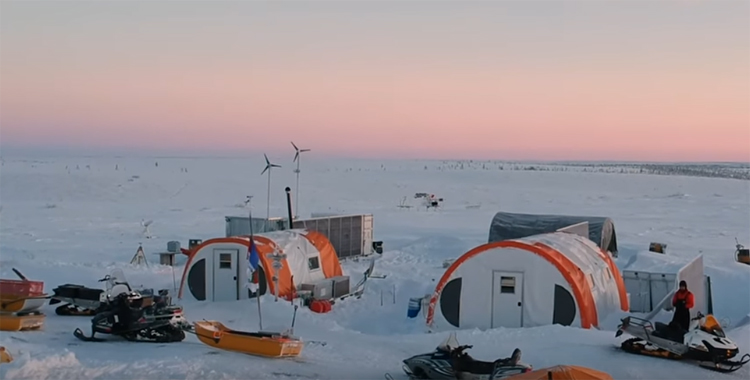|
|

|
  
Features
Update 2020/7/1 Teachers' Hub
brought to you in part by

LAURIER STUDENT RESEARCHER STUDIES SNOW HYDROLOGY IN NWT
By Suzanne Forcese
In the Canadian Western Arctic temperatures have increased at double the rate of the global average. This significant warming trend is leading to changing precipitation patterns, permafrost degradation, and increased shrub expansion into the tundra. These alterations are directly and indirectly affecting lake and river systems.
Researchers at Wilfrid Laurier University are studying the effects of climate warming in The Northwest Territories to assess how hydrological systems will change in the future.
When Dilshan Kariyawasam joined the Trail Valley Research team as a field assistant in 2017, he was to discover that the most challenging experience of his life would also become his greatest passion.

The Trail Valley Camp Virtual Tour where Laurier researchers study the effects of climate change on hydrological systems.(click on image)
WaterToday had the pleasure of speaking with Kariyawasam who is now completing his Master’s degree on Arctic Hydrology.
“On my first Arctic fly-in from Inuvik to the Research Station I thought I saw people but as we got closer I saw the vertical shapes were just sporadic small trees that dot the tundra. I suddenly felt so isolated and realized it would be a long seven weeks.”
There were only a few people at the camp and the rigors of lugging around heavy equipment in cold and rainy weather might have been a test to the average person. But for Kariyawasam who has always had a natural curiosity and adventurous spirit, it was the spark that ignited a zest to understand more about climate change in the Arctic.
|

|
“I always thought I wanted to be an engineer or maybe an architect until I took a class called ‘Earth and Space Science’ in my final year of high school. It was the first time material clicked with me. I realized I could take my knowledge outside of the classroom and explore the world.”
After a hydrology class with Dr. Phil Marsh, at Waterloo University, Kariyawasam knew he wanted to pursue the study of snow hydrology. It would also be a great opportunity to fulfill his life-long dream of Arctic exploration.
|
The Trail Valley Creek Research Station is located 50 km north of Inuvik, NWT and 60 km south of Tuktoyaktuk. Research started at this site in 1991 and operates year-round. Located in the tundra near the northern edge of the boreal forest, the 58 sq. km site around its namesake creek is underlain by ice-rich continuous permafrost. Patches of shrubs and forests as well as the shorter vegetation of the tundra make up the landscape.
The Inuvik-Tuktoyaktuk Highway (ITH) which opened in 2017 stretches from Inuvik to the Beaufort Sea and is Canada’s first all-season road to the Arctic coast. It also crosses the Trail Valley Creek Watershed. Long-term research and monitoring will provide knowledge and understanding on impacts of the ITH on this environment and impacts of changing stream flow or catastrophic lake drainage on the ITH.
Due to the rapidly changing climate in this region there is an urgent need on the part of territorial and federal government agencies, non-government organizations and Indigenous communities to understand how the changing
climate is impacting their shared water resources and ecosystems now and, in the future, and to transfer this knowledge to all Canadians.
“Our country is so large,” Kariyawasam adds, “Children grow up in a city – like me, growing up in the greater Toronto area—I thought all of Canada was the same. I think environmental issues have to be brought into the schools at a very early age.”
Kariyawasam told WT he is now driven to take the changing northern issues and his research into classrooms to create awareness with students.
So far that research is delving into the questions surrounding the reasons for lakes draining and drying up.
“I’m looking to use aerial imagery to construct a series of maps for some of the lakes surrounding Trail Valley Creek.”
The goal is to extend a currently existing record of imagery and demonstrate a prominent direction of change and provide a better understanding of hydrological activity.
The upper 10 metres of permafrost are extremely rich and very sensitive to warming. Ice-wedges are showing signs of melting, and permafrost-controlled lakes are rapidly draining as ice-rich permafrost melts. Changes are being monitored from historical aerial photographs and satellite images and from measurements on the ground.
“We’ve been tracing the shorelines over the years and have noticed four or five clusters with lakes drying and draining. We’re still determining the reasons.”
“Ice-rich lakes will produce catastrophic drainage. Also with more sunlight the melt accelerates. More vegetation also attracts more sunlight.”
Permafrost thaw is beginning to cause the ground surface to subside with resulting changes in stream channels. It is likely that this will cause dramatic ecosystem changes in the coming decades. These changes are being monitored
to better understand the impacts of warming and disturbance on ecosystems and water resources.
“There are over 3600 lakes and it is very easy to make the assumption that some are more important than others. But these lakes are still used for navigation. The resources are still valuable. The smaller lakes have smaller fish for example. Those fish help to contain wild life, birds, vegetation. Each lake is important.”
Kariyawasam also points out the immense value of the relationships he has built in the area over the past few years.
“As a scientist, we are trained to think we are the professionals but there is a whole other side in Traditional Knowledge which is perhaps even more valid than our western approach.”
“Most Canadians don’t understand what the North is like—I didn’t. It’s a very different experience. Not everyone has an opportunity to be dropped off in an isolated area. There is a huge disparity in life style and opportunities between most Canadians and the northern communities.”
Cultivating those relationships was “a bit delicate,” Kariyawasam adds, “but the Indigenous community was attracted to me – perhaps they saw a difference, that I looked more like them.”
Kariyawasam adds that perhaps past mistrust had been created by resource extraction from outside companies that would build infrastructure and then leave once the resources were depleted.
“We have developed great relationships and visit schools in Tuktoyaktuk. We show our techniques to sample snow and measure water velocity. We let the kids check out our drone. They love it!”
Field work remains the cornerstone of Laurier’s northern research. Dilshan Kariyawasam’s work focused on the effects of climate change on Arctic hydrology is still ongoing as he completes his Master’s thesis.
For now, the current world pandemic has hit the pause button on research in the Arctic. Dilshan Kariyawasam eagerly anticipates that next flight back to the Trail Creek Research Station.
“I love the Arctic, the people, and the idea of educating Canadians about the impacts of climate change on all of us.”
Please enjoy Dilshan Kariyawasam’s video Courtesy Northern Water Futures (Friday Features)
suzanne.f@watertoday.ca
|
|
|
Have a question? Give us a call 613-501-0175
All rights reserved 2025 - WATERTODAY - This material may not be reproduced in whole or in part and may not be distributed,
publicly performed, proxy cached or otherwise used, except with express permission.
|
| |